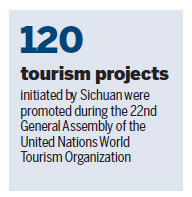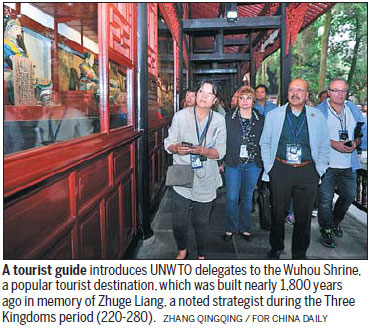Western megacity looks to huge boon in eco-friendly development
Hosting the 22nd General Assembly of the United Nations World Tourism Organization in mid-September proved to be a huge boon to Chengdu's tourism development.
During the event, the host city, capital of Sichuan province, launched a select group of 120 tourism projects worth more than 685.3 billion yuan ($104 billion) in combined investment value, seeking investors.
They cover a variety of sectors including rural tourism, holiday resorts and urban forest parks.
Of the projects, six were signed at the UNWTO general assembly, raising a total of 61 billion yuan. The signed deals included a strategic partnership between the city and HNA Group.
The Hainan-headquartered group's subsidiary HNA Tech is to set up a tech startup fund of at least 30 billion yuan at the Chengdu Hi-Tech Industrial Development Zone.
The new fund will invest in HNA Tech's western headquarters, a high-tech startups park, a cooperative bank for technological innovation and other high-tech startup projects.
Another subsidiary of the group company, HNA Modern Logistics, will spend 20 billion yuan in building a 226.7-hectare model airport industrial zone, which is designed to house modern logistics, air shipment facilities, aviation companies and other related facilities.
As the start of the southern Silk Road, Chengdu enjoys distinct advantages for development, said Chen Feng, board chairman of HNA Group.

"HNA will continue supporting Chengdu's socioeconomic development against the backdrop of the Belt and Road Initiative," he said. "I hope the cooperation will enable both HNA and Chengdu to take off."
Zhang Guoqiang, general manager of the western region of Ctrip, a major internet company focusing on tourism, said his company had poured 100 million yuan into building its big databased smart tourism operation's headquarters in Chengdu, with its business expected to reach Southeast Asia.
While Ctrip tends to opt for Shanghai - where the group is headquartered - as the location for most of its large projects, Chengdu is an exception, he said.
After the UNWTO assembly, Ctrip will increase its investments in the western region, Zhang said.
Chengdu boats a large number of tech professionals, who can provide strong support for the company's big data business. Meanwhile, the city's well-established tourism industry has positioned itself at the forefront of western China in terms of smart tourism, and provides a great deal of opportunities for dotcoms, he said.
"We will serve our clients better and faster, via big data (technologies)."
Chengdu has maintained brisk growth momentum.
The city reported 20 percent compound annual growth in tourist numbers from 2009 to 2016, ranking the city No 2 worldwide, according to data from Mastercard.
Chengdu has made National Geographic Traveler's list of 21 must-see destinations for 2017 for its vigor, history, cultural heritage and culinary delights, the only one from China on the list.
As China is experiencing economic transformation and industrial restructuring, tourism, as an emerging sector, is also reporting momentum in growth.
With rich cultural and historical heritage and unique scenery, Chengdu is accelerating its pace in developing itself into an international tourist destination.
Making full use of its winning features - including giant pandas, its cuisine, music, poetry and culture - the city is advancing with a combination of tourism and other sectors including culture, agriculture, industry and services.
According to the city's development plan, a new urban forest park will take shape on Longquan Mountain in the east of Chengdu in 2020, with a planned area of more than 1,000 square kilometers.
The city government has projected tourist visits to hit 234 million by the end of the 13th Five-Year Plan period (2016-20), including 4.8 million from overseas.
The tourists are forecast to generate 520 billion yuan in tourism revenue by then, contributing 11.67 percent to the city's GDP.

(China Daily 09/28/2017 page10)














